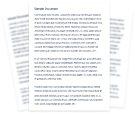Commercial Lease Agreement (Non-Retail) (Other Jurisdictions)
This Lease Agreement can be used for all non-retail commercial leases in jurisdictions across Australia besides New South Wales, Queensland and Victoria.
(0 reviews)
Under 30 minutes
Suitable for Australian Capital Territory, Northern Territory, South Australia, Tasmania and Western Australia only
Document Overview
A lease is a contractually binding agreement under which one person conveys to another person, a right to the exclusive possession of land for a fixed or renewable period of time, usually in return for a periodical payment of money.
What is a commercial lease?
A commercial lease is a category of lease under which the premises are used for the carrying on of a business. A “retail lease”, as distinguished from a “commercial lease” is a lease that is governed by relevant retail leases legislation. In Australia, each jurisdiction has enacted its own retail leases legislation that governs “retail leases” in that jurisdiction. As noted above, this precedent does not apply to a retail lease. In practical terms, this means that this precedent applies to a lease of business premises that is not governed by the relevant retail leases legislation.
What is a retail lease?
As noted above, a “retail lease” is a lease that is governed by relevant retail leases legislation. In this regard, each jurisdiction prescribes the types of premises, leases or businesses that are governed by the relevant retail leases legislation in that jurisdiction and, while there is some overlap between the jurisdictions, there is no overall national uniformity. For example:
- in South Australia, the Retail and Commercial Leases Act 1995 (SA) also excludes leases under which the rent exceeds a prescribed monetary threshold. Recent amendments to the Act also confirm that a lease in South Australia may fall in and out of the ambit of the Act during the term of the lease. For example, if, during the term of a lease, the prescribed threshold is increased to an amount in excess of the rent payable under the lease, the lease will at that time fall within the ambit of the Act. This is in stark contrast to the position in Victoria where the application of the Retail Leases Act 2003 (Vic) to a lease is determined at the commencement of the lease, ie if the Act applies at the commencement of a lease, then it continues to apply even if, during the term of the lease, the occupation costs at some late stage exceed the prescribed monetary threshhold; and
- in Western Australia, the Commercial Tenancy (Retail Shops) Agreements Act 1985 (WA) excludes shops that have a lettable area of 1000 square metres or more and certain leases under which the tenant is a listed company or a subsidiary of a listed company.
The above examples do not cover all of the differences that exist between the relevant retail leases legislation in each jurisdiction. They simply serve as reminder to legal practitioners to review the relevant retail leases legislation if proposing to draft a “commercial lease”. In that situation, legal practitioners need to ensure that they are not in fact drafting a “retail lease” that will end up being subject to the relevant retail leases legislation.
Merely naming a document a “commercial lease” and purporting to exclude the application of the relevant retail leases legislation does not preclude the application of the relevant legislation. It is the substance and not the form of the lease that is determinative.
Registration of lease
South Australia
In South Australia, the Real Property Act 1886 (SA) protects a tenant in actual possession of land under an unregistered lease for a term of not more than 1 year: see section 119. Accordingly, most commercial leases need to be registered in order to protect a tenant’s indefeasibility of title.
Any land intended to be leased for a term of more than 1 year must in the prescribed form: see section 116 — Form L1. This form, the annexure form (Form B1) (if required) and the applicable guidance (on completing the form) can be downloaded from the Land Services SA website.
Western Australia
In Western Australia, it is not possible to register a lease for a term of 3 years or less. A lease for a term exceeding 3 years must be in the approved form: see section 91 of the Transfer of Land Act 1893 (WA).
The interest of a tenant in actual possession of land under a lease for a term of 5 years or less is statutorily protected: see section 68(1A) of the Transfer of Land Act 1893 (WA).
See the Landgate website for a Lease form (Form L1). Completion instructions are on the last page of the form. All forms must be printed double-sided.
Tasmania
In Tasmania, a lease with a term of 3 years or less cannot be registered; however, the interest of a tenant in possession under a lease with a term of 3 years or less is statutorily protected: see section 40(3)(d)(ii) of the Land Titles Act 1980 (Tas).
Accordingly, a lease for a term in excess of 3 years needs to be registered in order to protect the indefeasibility of the tenant’s interest under the lease.
See the Land Information System Tasmania (LIST) website for the Memorandum of Lease form and the accompanying dealing information. Completion instructions can be found on the website (see General Guide To Completing The L Form).
A lodgment form also needs to be prepared in addition to the lease. The lodgment form and a guide to completing the lodgment form can also be found on the LIST website.
Northern Territory
In the Northern Territory, the interest of a tenant in actual possession under a lease with a term (including a right to renew or extend the term) of 3 years or less is statutorily protected: see the Land Titles Act 2000 (NT) — sections 188 and 189 and the definition of “short lease” in section 4.
The relevant form required to register a lease in the Northern Territory is Form 31, which can be downloaded from the Northern Territory government website. Completion instructions, including witnessing requirements, can be found at the end of the form. Form 95 (Annexure sheet) should be used to annex the provisions of the lease to Form 31 and the third box under the heading “Covenants” on page 2 of Form 31 should be marked accordingly. The second box also needs to be marked if the conditions and covenants implied by sections 117 and 119 of the Law of Property Act 2000 (NT) do not apply to the lease.
Australian Capital Territory
In the ACT, the Land Titles Act 1925 (ACT) provides statutory protection to an unregistered lease with a term of 3 years or less (see section 58(1)(d)) and a registered lease is subject to any prior unregistered lease, or agreement for lease, with a term of 3 years or less; however, it is not subject to any option to purchase or renew contained in an unregistered lease: see section 85.
Accordingly, a lease with a term of more than 3 years needs be registered in order to protect the indefeasibility of the tenant’s interest under the lease.
The relevant form required to register a lease in the ACT is Form 072 — SL — Sublease. See the Access Canberra website for the form and applicable fees.
View Sample Commercial Lease Agreement (Non-Retail) (Other Jurisdictions)
It's never been so easy
Sign-up to a free Lawpath account
Get started and we'll take care of you. It's that easy.
Browse our 500+ legal documents
Browse our 500+ legal documents to find the perfect match to cover your business needs. We've got Compliance, Employment, Service agreements and more.
Collaborate with e-Sign and Sharing
Having access to your legal documents has never been easier. You can request e-signature, share the document and download for an efficient collaboration.
Create unlimited legal documents and eSignatures for only $39/month.
Upgrade to a Lawpath legal plan to boost your new business.


Here's what people say about Lawpath's Commercial Lease Agreement (Non-Retail) (Other Jurisdictions)
Reviews are managed by BazaarVoice and comply with the BazaarVoice Authenticity Policy. Reviews are independently verified by BazaarVoice and detail our customers' real experiences.
0 reviews
Most Recent
Highest to Lowest Rating
Lowest to Highest Rating

